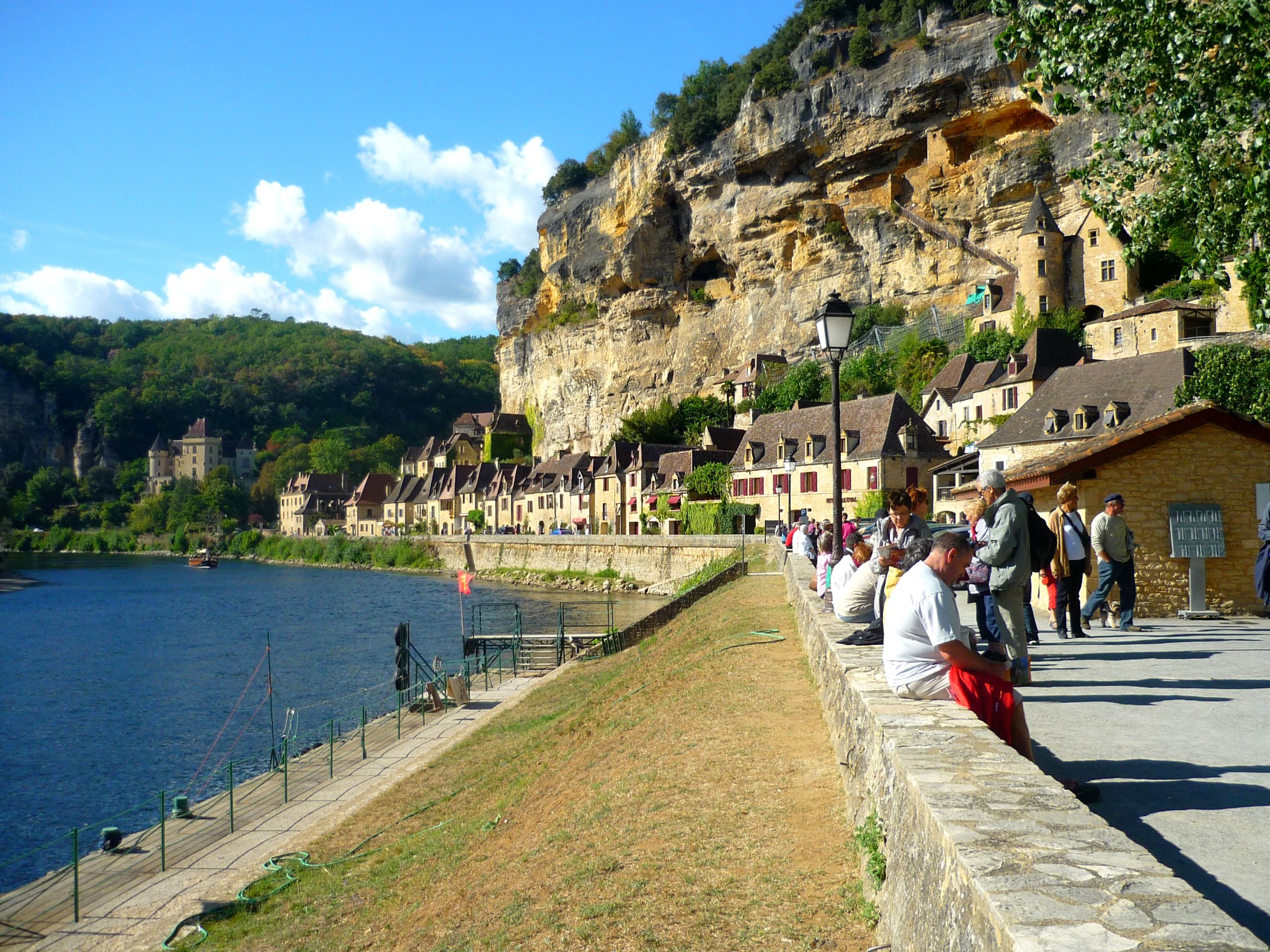From Souillac to Trémolat, the Dordogne Valley flows through the region of Périgord Noir.
Along the peaceful, scenic roads set along the shores of the Dordogne River are charming old Périgordian villages, tranquil gardens and remarkable views to discover.
The region’s stars are definitely the looming castles that witnessed conflicts and battles, such as the Hundred Years’ War between the French and the English and the Wars of Religion between Catholics and Protestants.
The main sites of the Dordogne Valley
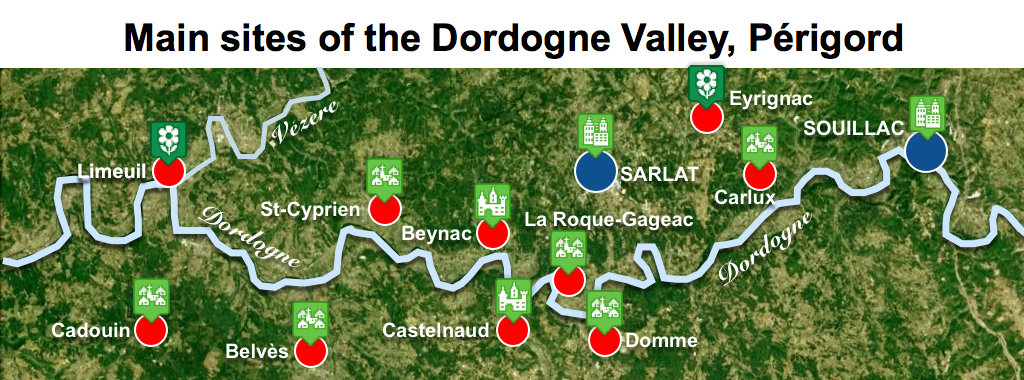
From the Early Middle Ages, the prosperous villages situated along the Dordogne Valley between Limeuil and Souillac grew in importance as all economic activity and transport were centred on the Dordogne River.
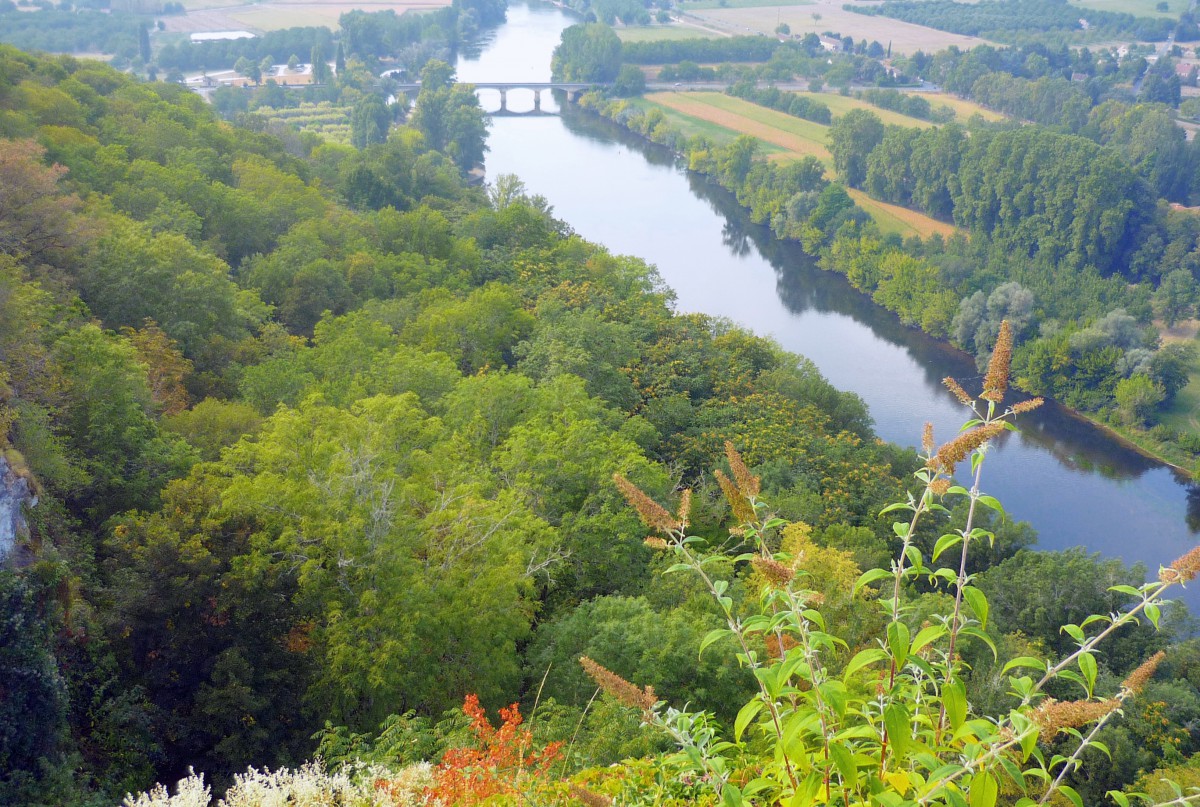
A coveted land
The French and the English coveted their strategic positions during the Hundred Years War. The fortified villages and their castles suffered greatly from the conflict, and they changed hands many times between France and England.
When the Hundred Years War ended with the French victory at Castillon-la-Bataille, an era of prosperity started in the region with the growing importance of river trading.
From the Middle Ages until the end of the 18th century, the harbours of little towns such as Limeuil, Beynac, La Roque-Gageac and Souillac were busy places.
There, small barges (locally called Gabares or Gabarres) arriving from the Massif Central unloaded their load of chestnut wood, cheese, wool, and leather.
The goods were stored on-site before being loaded onto larger barges for transport to Bergerac or Bordeaux.
There, the wood was made into wine vats and barrels. The boats returning from Bordeaux carried spices, sugar, salt and dried fish from the ocean.
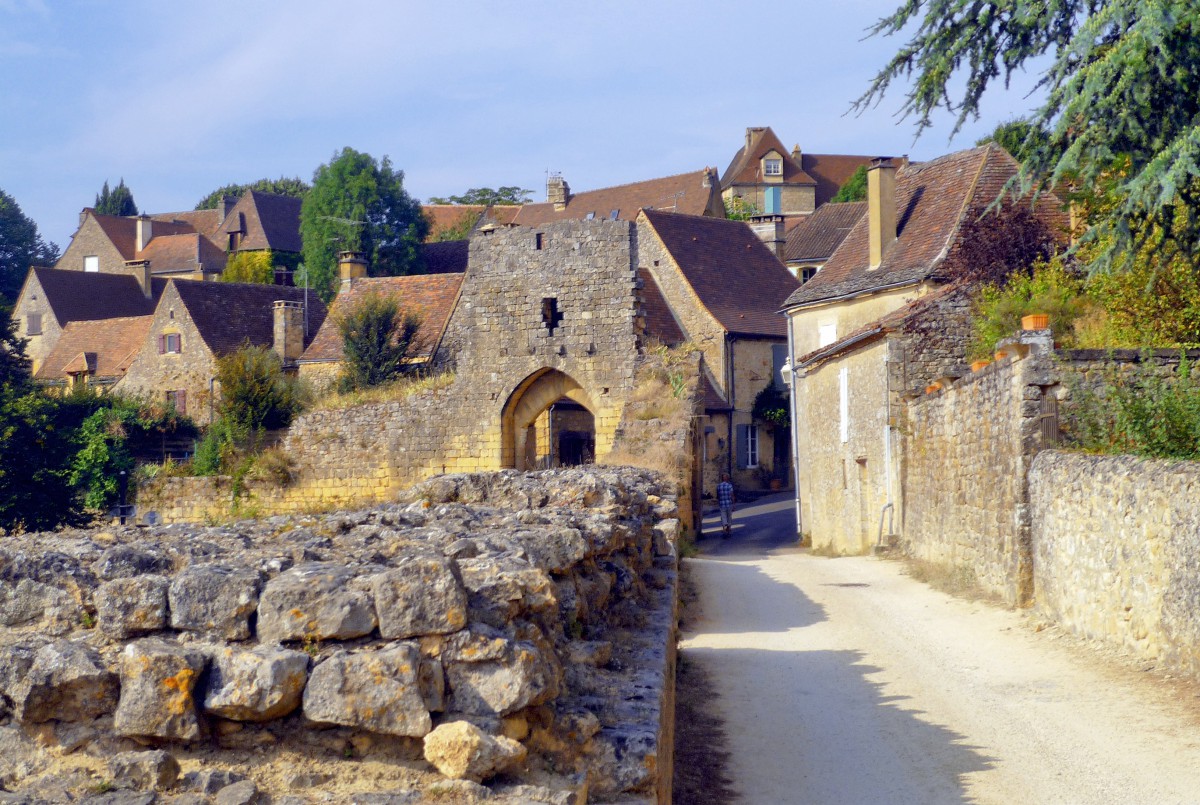
This era of prosperity was temporarily halted in the 16th century due to other conflicts:
- the Wars of Religion and
- the Peasant Revolt of the Croquants.
Both conflicts lasted until the 17th century.
From the arrival of the railway to the development of tourism
The villages and towns of the Dordogne Valley flourished again in the 19th century thanks to the importance of river trading, bringing prosperity and wealth.
However, in the second half of the 19th century, the river trading on the Dordogne met its decline with the coming of the railway line between Bordeaux and Aurillac.
Today, the Dordogne Valley thrives as a solid touristic region, welcoming millions of visitors annually.
The beauty of the landscapes is particularly appealing to British people, many of whom have bought a property there.
Beautiful Villages of the Dordogne Valley
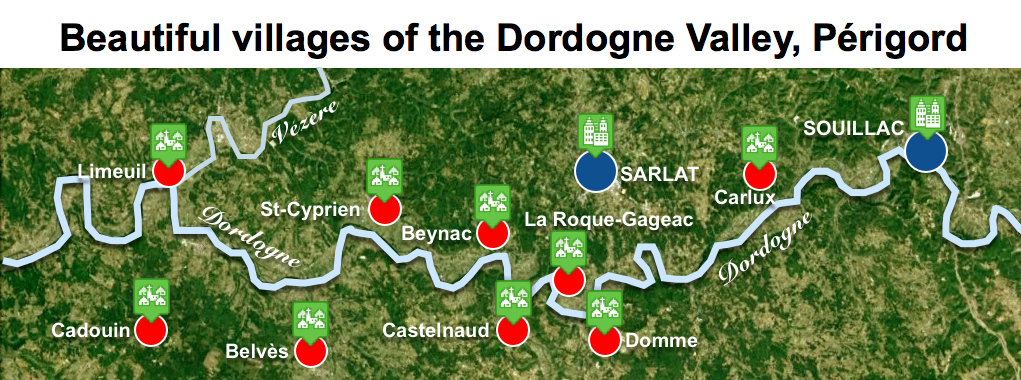
The Dordogne Valley in Périgord Noir includes charming villages, some of them listed as France’s most beautiful villages by the association “Plus beaux villages de France“:
- Carlux,
- Domme,
- La-Roque-Gageac,
- Castelnaud-la-Chapelle,
- Beynac,
- Saint-Cyprien,
- Belvès,
- Cadouin and
- Limeuil.
Carlux
![The lantern of the dead or "Saracen Chimney" in Carlux © Jochen Jahnke - licence [CC BY-SA 3.0] from Wikimedia Commons](https://frenchmoments.eu/wp-content/uploads/2012/11/Carlux-LR-©-Jochen-Jahnke-licence-CC-BY-SA-3.0-from-Wikimedia-Commons.jpg)
The picturesque village of Carlux, perched on a rocky spur, is located 12 km from Sarlat and Souillac. It is a typical Périgordian village with its honey-coloured façades and roofs covered with lauzes (stone roofing). The feudal castle in ruins overlooks the town.
An interesting architectural feature in Carlux is the odd Saracen chimney, a lantern of the dead dating back to the 11th century.
The village has kept its small market hall from the Middle Ages (14th century). The portal of the St. Catherine church has been listed by the French Government since 1926. The church’s lack of ornamentation is due to its construction during the Hundred Years War.
The sanctuary, of Romanesque and Gothic styles, shelters a polychromed Piéta from the 17th century.
Another tourist attraction in Carlux is the intimate Gardens of Cardiot, with its terraces overlooking the Dordogne. The gardens can be visited from May to October.
The bastide of Domme

On the left bank of the Dordogne River, the site of Domme is one of the most visited in the region. The village is often nicknamed “the Acropolis of Périgord”, about that of Athens.
The village is an old bastide (fortified town) from the 13th century, built on a hill 150 metres above the Dordogne River.
Contrary to old walled towns (such as Carcassonne or Provins), a bastide usually had a rectangular layout.
However, the bastide of Domme is trapezoidal due to the natural abruptness of the village site.
Therefore, Domme is an excellent example of medieval military architecture.
The streets are consistent with Domme’s geometrical layout, and its ramparts are right at the edge of the cliff.
The fortified royal bastide has been well-preserved since its foundation by King Philippe III (le Hardi) in 1281 during the Albigensian Crusade. In addition, it boasts a fine view over the Dordogne Valley.
Find out more about Domme.
La Roque-Gageac: a riverside village

La Roque-Gageac is arguably one the most beautiful places in Périgord Noir, or at least one of the most photographed in southwestern France.
Listed as one of France’s most beautiful villages, the riverside town is built along the right bank of the Dordogne River against a towering limestone cliff. This unique setting of narrow, peaceful streets and cliff-dwellings also enjoys a subtropical microclimate.
The medieval village is a mix of humble cottages and the dwellings of the former gentry, its houses squeezed between the Dordogne River and the towering cliff. The stepped narrow streets lead up to the Manoir de Tarde, which dominates the village.
Find out more about La Roque-Gageac.
Castelnaud-la-Chapelle
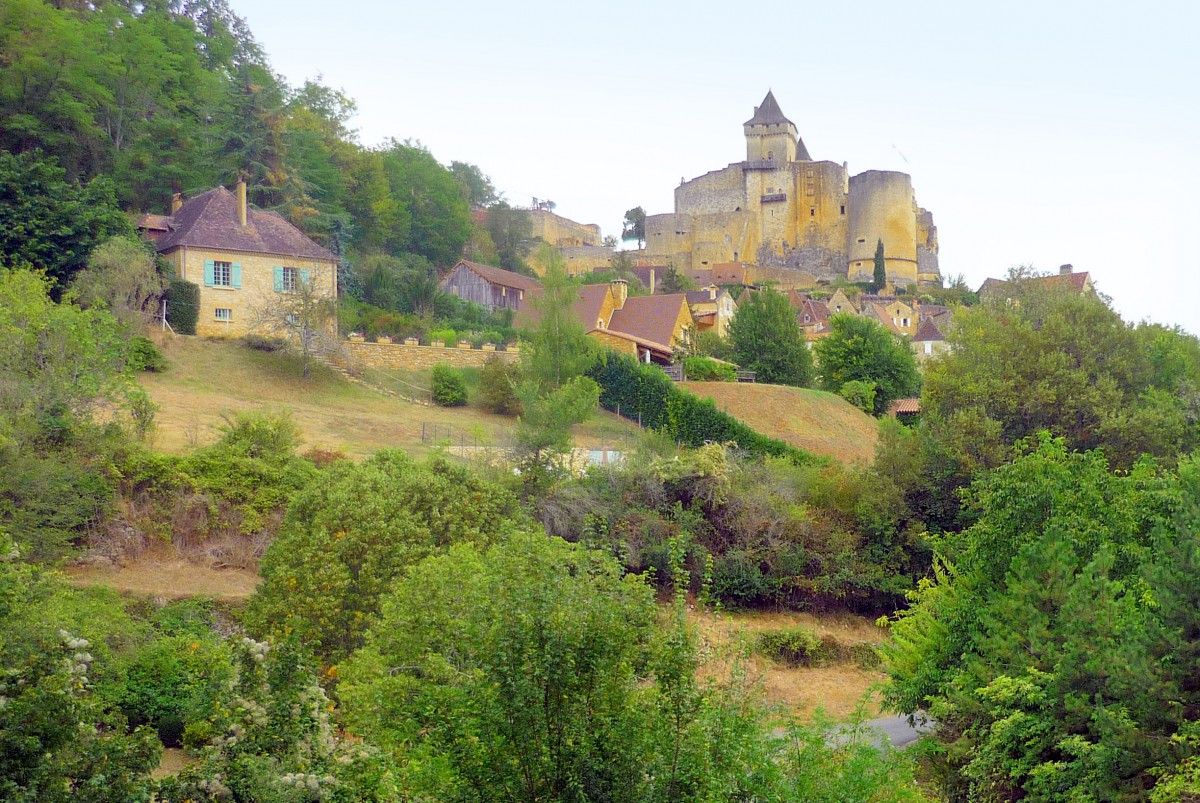
On the left bank of the Dordogne River, the picturesque village of Castelnaud-la-Chapelle is dominated by an impressive fortress, one of the most visited castles in the South of France.
During the Middle Ages, Castelnaud was occupied by the English, whose castle commanded the strategic position at the meeting of the Dordogne and the Céou Rivers, opposite the rival French castle of Beynac.
Find out more about Castelnaud-la-Chapelle.
Beynac-et-Cazenac

The strategic position of Beynac is a point of interest in the Dordogne Valley, which can not be ignored.
From the very start, the village will charm you with its cobbled, steep little lanes and stairways that climb up to the formidable castle, where the view is breathtaking.
It is therefore unsurprising that Beynac gained the prestigious title of “one of the most beautiful villages of France” with its houses clinging majestically to the cliff-face.
Read more about Beynac.
Saint-Cyprien
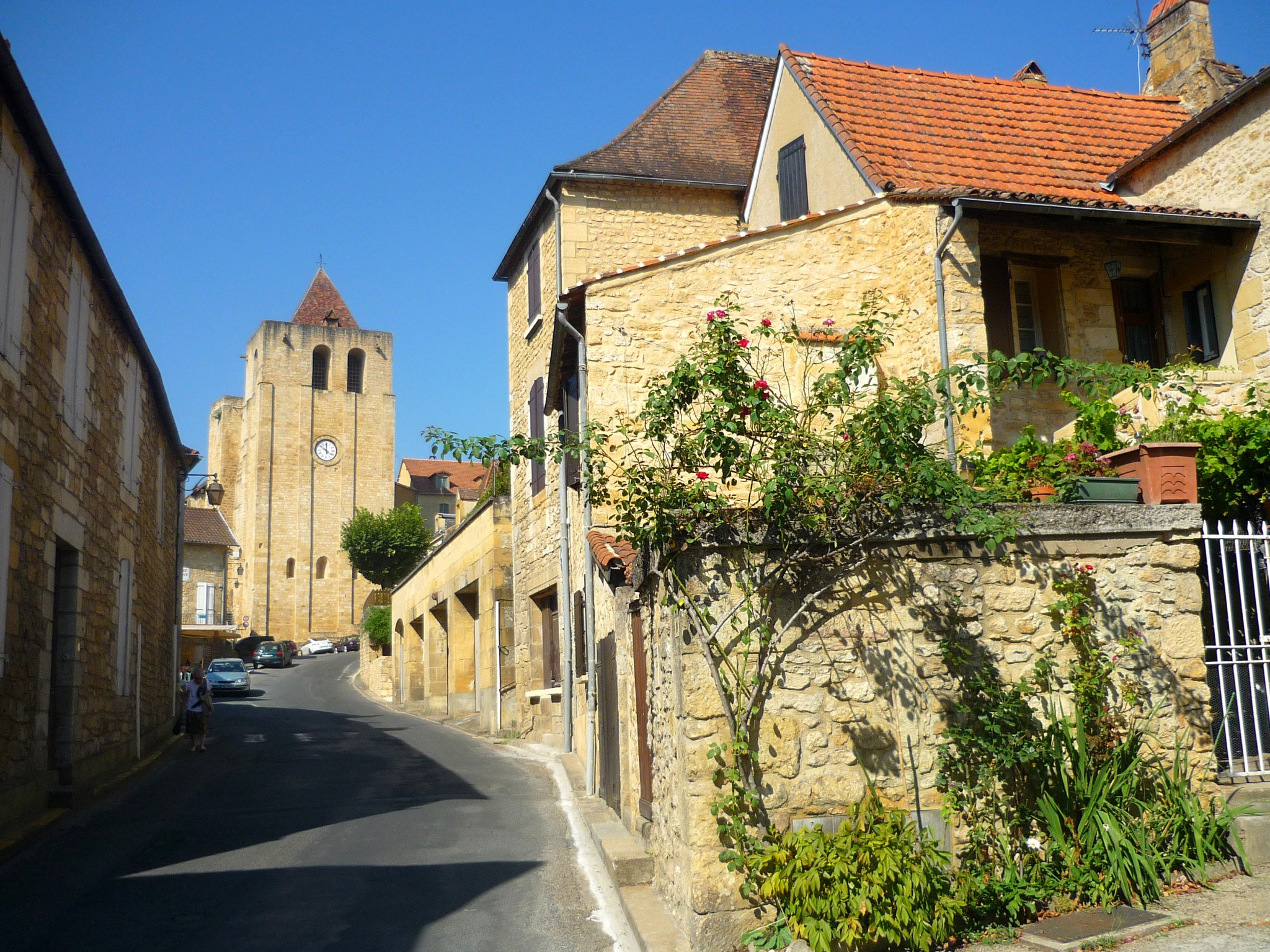
Saint Cyprien enjoys an enviable position established on a hillside on the right bank of the Dordogne Valley.
The narrow streets wind uphill towards the abbey church, which dominates the charming village, and look down on the typical Périgordian roofs.
Read more about Saint-Cyprien.
Belvès

The medieval little town of Belvès is situated on the route to Biron Castle.
Listed as one of France’s most beautiful villages, Belvès is locally known as the “Town of seven bell towers”.
The narrow streets of the medieval district (the Castrum) lead to the 15th-century market hall, the 11th-century belfry and the remains of a 14th-century castle and the Town-Hall.
Outside the limits of the Castrum stands the Church of Notre-Dame de Montcuq.
Edified in the Gothic style between the 13th and 15th centuries, it was part of a powerful priory.
Cadouin
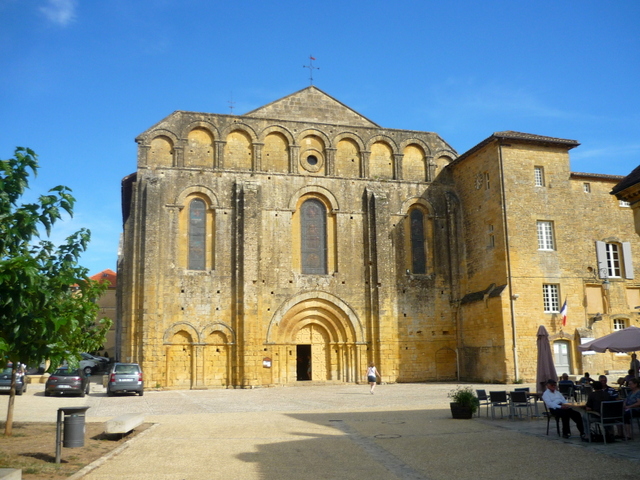
The village of Cadouin is 40 km from Sarlat and 35 km from Bergerac, at the border between the Périgord Noir and Périgord Pourpre. The little village is famous for its Cistercian abbey, which features an interesting church and fine cloister.
Since the Middle Ages, Cadouin has been a stage on the pilgrim route to Santiago de Compostela in Spain.
Eleanor of Aquitaine and her son Richard the Lion Heart were famous pilgrims who stopped there. The abbey is a World Heritage Site listed by Unesco as part of the pilgrim route to Santiago de Compostela.
The village also has some typical Périgorian houses and a market hall.
Limeuil
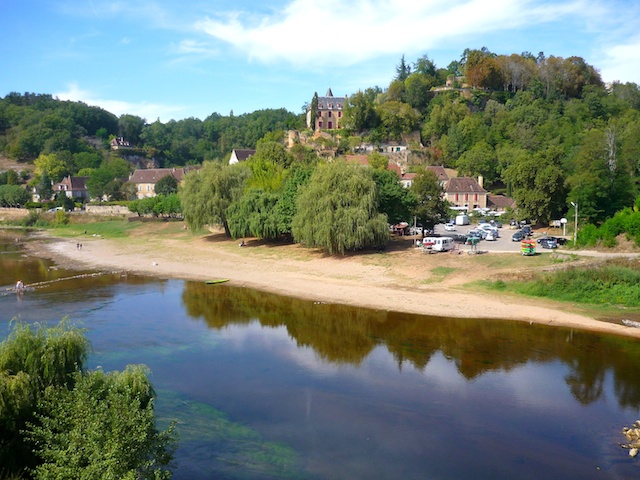
The village of Limeuil is located at the confluence of the Dordogne and the Vézère Rivers in the province of Périgord.
Limeuil is a perfect ‘picture postcard’ village. Cobbled streets wind between peaceful gardens and honey-coloured houses with deep red or light blue window shutters.
It is no accident that Limeuil has been listed as one of France’s most beautiful villages.
Read more about Limeuil.
Beautiful castles of the Dordogne Valley
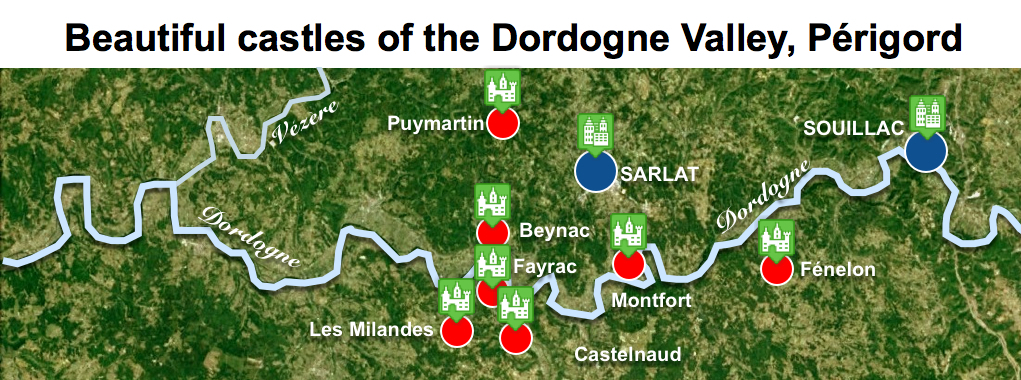
The construction of castles in the Dordogne Valley began in the 11th and 12th centuries.
Most were later enhanced with better defensive mechanisms during the medieval battle of the Hundred Years’ War between the kingdoms of France and England.
Castles are generally located on inaccessible sites, such as rocky outcrops or hillocks encircled by bogs (Beynac, Castelnaud).
In addition, the proximity of main access roads along the Dordogne River to the castles was strategically efficient in granting or denying the right of way.
After the war, and from the 16th century onwards, the Renaissance influence brought to light comfort and a certain extravagance to some of the castles (particularly in Les Milandes), with elements evoking the chateaux of the Loire Valley.
Fénelon Castle
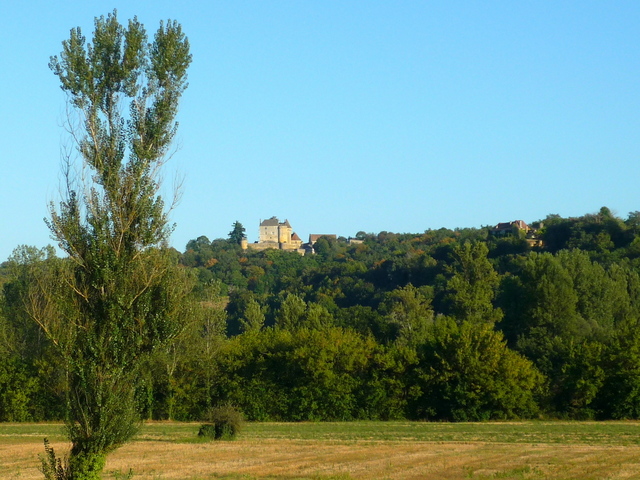
The castle of Fénelon is the first impressive Périgordian fortress of the Dordogne Valley, which was revealed when coming from Souillac.
Set on a rocky promontory overlooking the Dordogne Valley, it is located in the village of Sainte-Mondane.
The foundations of Fénelon Castle date back to the 14th century. It played a significant role as a strategically situated fortress during the Hundred Years War.
Its roof is still covered with “lauzes”, the local stone roofing traditionally used in the Périgord.
The castle is the birthplace of François de Salignac de la Mothe Fénelon (1651-1715), archbishop of Cambrai, tutor of the King’s children, and author of “The Adventures of Telemachus,” first published in 1699.
Today, visiting the castle and observing the triple walls and terraces surrounding it is possible.
Inside, there is a collection of weapons and armour, tapestries, and fine furnishing from the 15th to the 18th centuries.
Rouffillac Castle
![Rouffillac Castle © Père Igor - licence [CC BY-SA 3.0] from Wikimedia Commons](https://frenchmoments.eu/wp-content/uploads/2012/11/Rouffillac-Castle-LR-©-Père-Igor-licence-CC-BY-SA-3.0-from-Wikimedia-Commons-.jpg)
Facing Fénelon on the other side of the Dordogne River is the silhouette of Rouffillac Castle, surrounded by twelve acres of park and woodland.
The fortified manor of the 17th century was enlarged and transformed into an elegant Renaissance chateau in the 19th century.
With its cool and shaded interior courtyard, swimming pool, and terraces overlooking the Dordogne Valley, the castle is a holiday residence with eight large bedrooms richly decorated in Louis XIII, Louis XV, or Louis XVI style.
Montfort Castle
Between the villages of Vitrac and Carsac-Aillac, the Montfort castle stands in a grandiose setting, highly coveted for centuries.
Thus, it is not surprising that the castle’s history is littered with sieges and battles. Taken in 1214 by Simon de Montfort, it was dismantled and rebuilt five times until 1606.
The fortress was renovated extensively during the 19th century when a loggia was added, and a series of small lanterns gave it a “whimsical look of a stage set for a light opera”, according to the Michelin Green Guide.
Montfort castle was repaired under the bloodthirsty Lord Bernard de Casnac and his wife Alix de Turenne, who were feared for their cruelty against the Catholics in his territory.
Montfort Castle is not open to the public.
La Malartrie Castle

At La Roque-Gageac, in the direction of Beynac, the Château de la Malartrie is a pastiche of a 15th-century castle built in the 19th century on the site of a former leprosy colony: “la maladroit.”
It was built according to the local architectural trends for the Count de Saint-Aulaire, a French ambassador to England and member of the Cincinnati Franco-American society.
Nowadays, the chateau can be rented for a short stay in Périgord Noir.
Castelnaud Castle

The most visited castle in the South of France dominates the picturesque village of Castelnaud-la-Chapelle on the left bank of the Dordogne River.
During the Middle Ages, the mighty English fortress commanded the strategic position at the Dordogne and the Céou Rivers meeting, opposite the rival French castle of Beynac.
A visit to Castelnaud Castle can be unaccompanied. It takes approximately one hour to discover the interior, including the machinery room, the guard room, the artillery tower, the defensive equipment room, the keep, and the “chemin de ronde” (a protected raised walkway behind the ramparts) through many winding stairways and small chambers that children will be excited to discover.
The extensive and fascinating Museum of Medieval Warfare was inaugurated in 1985 under the leadership of Kléber Rossillon.
It features an important collection of weapons and armoury from all over Europe, punctuated by furniture and structural models.
Outside, high on the battlements, are displayed the most powerful siege engines, which have been reconstructed full-scale to recreate the turbulent atmosphere of various past moments: bombards, trebuchets, mangonels, giant crossbows, and catapults.
The view of the Dordogne Valley from the terraces is remarkable. It stretches from the village of La Roque-Gageac to Marqueyssac opposite and Beynac Castle to the right.
Find out more about the castle of Castelnaud-la-Chapelle.
Fayrac Castle
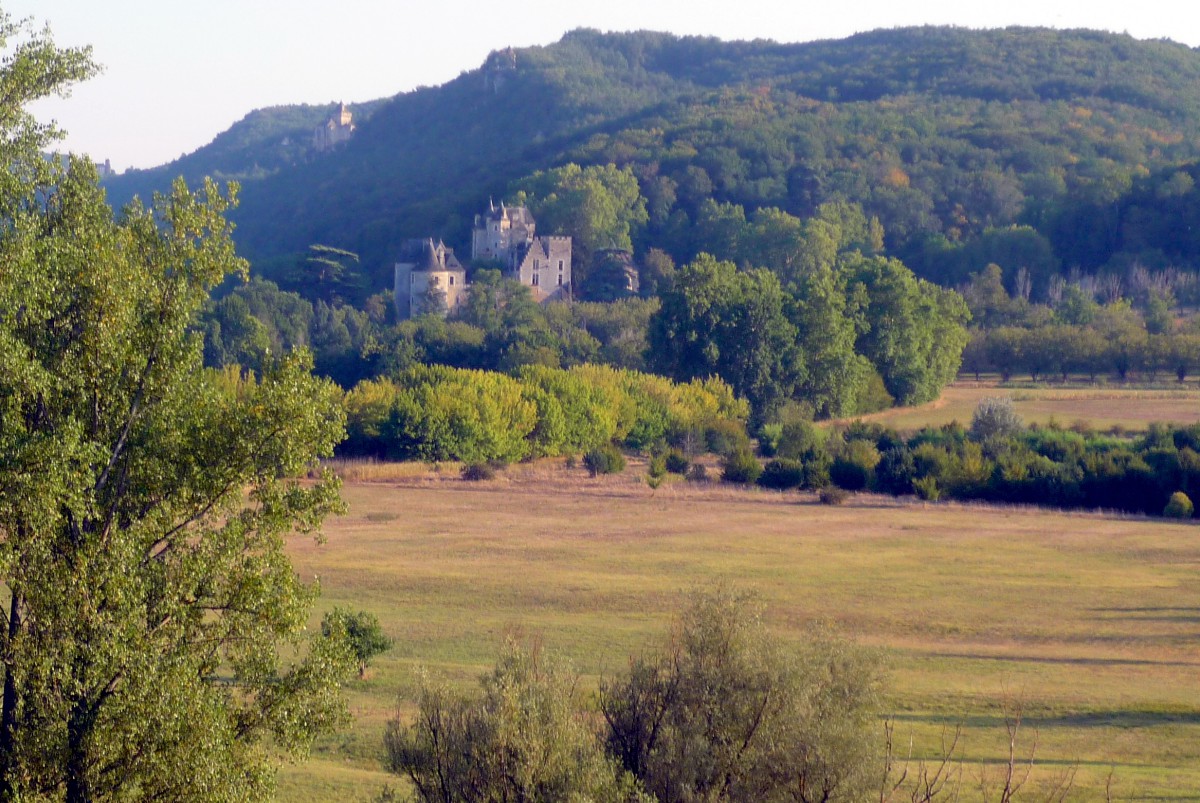
Built on the top of a hillock next to the Dordogne River with a view over Beynac Castle, Fayrac Castle is the least known of them in this part of the Dordogne Valley, mainly because it cannot be visited.
However, there are good views of it from the path next to the ramparts.
Construction of the castle took place from the 13th century onwards, with double curtain walls (for defensive purposes) and a double moat with only two drawbridges.
Located very close to Castelnaud Castle, Fayrac was an English stronghold during the Hundred Years’ War, with a strategic lookout over the French position in Beynac Castle on the other side of the Dordogne River.
Fayrac consists of two lodging houses from the 15th and 16th centuries.
They display Gothic and Renaissance architectural elements, including round towers and turrets with pointed slate roofs. The keep was only built in the 19th century when the castle was renovated extensively.
Beynac Castle

Visits to Beynac Castle have been organized so that visitors discover it the same way a knight would have upon first arriving at the fortress: the dark guardroom, the 14th-century kitchen, the great Hall of State, and the Hall of State.
The last staircase to the top of the keep climbs to the watchpoint, which looks towards the south bastion.
The panoramic view encompasses the Dordogne Valley and the castles of Marqueyssac, Castelnaud, and Fayrac.
Before leaving the Castle plateau, be sure to visit the Romanesque Chapel with its roof of lauzes, which was given to the municipality of Beynac-et Cazenac.
Find out more about Beynac.
Les Milandes Castle
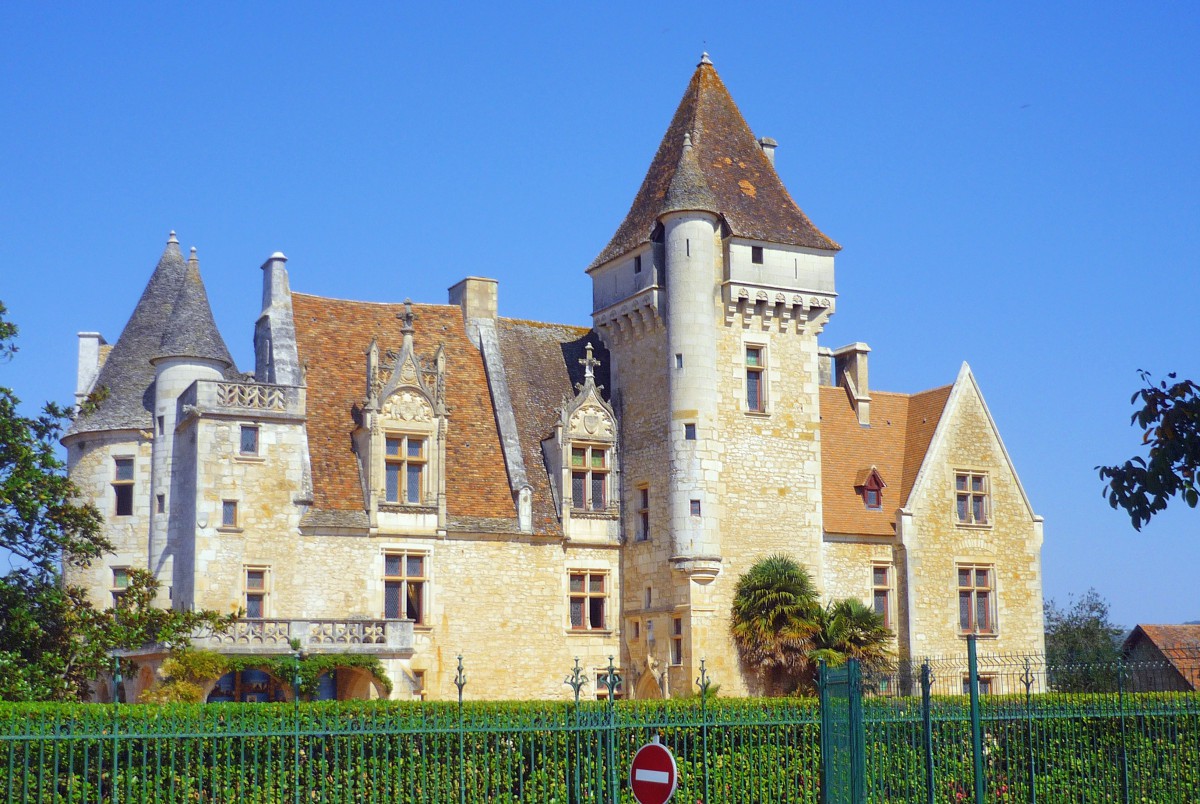
Famously known as “Josephine Bakers’ castle”, Les Milandes is a Renaissance chateau that benefits from a beautiful view over the Dordogne Valley.
It is located on the left bank of the Dordogne River, in the commune of Castelnaud-la-Chapelle, a little further West than Beynac-et-Cazenac.
In 1986, the French government listed Les Milandes as a historical monument.
Find out more about Les Milandes.
Monrecour Castle
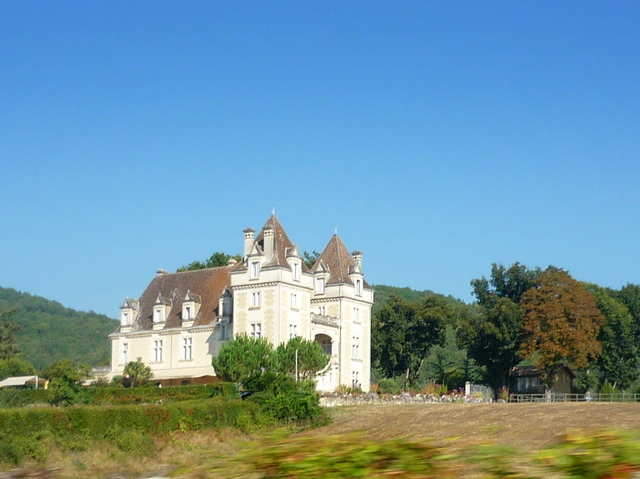
On the other side of the valley, opposite Les Milandes, Monrecour Castle is a Neo-Renaissance building in Saint-Vincent-de-Cosse between Beynac and Saint-Cyprien.
The chateau is a holiday residence with a restaurant and a helicopter landing pad.
Although not a castle built in the Middle Ages, its impressive size can be appreciated from the D703 road.
Puymartin Castle
![Puymartin © Manfred Heyde - licence [CC BY-SA 3.0] from Wikimedia Commons](https://frenchmoments.eu/wp-content/uploads/2012/11/Puymartin-LR-©-Manfred-Heyde-licence-CC-BY-SA-3.0-from-Wikimedia-Commons-.jpg)
Situated 8 km from Sarlat on the road to Les Eyzies, Puymartin Castle is recognisable by its beautiful crenellated towers.
The foundations of the castle date back to 1270.
Destroyed during the Hundred Years War, it was rebuilt around 1450 and heavily restored in 1890. The castle is open to visitors.
Beautiful Gardens of the Dordogne Valley

The Dordogne Valley in Périgord Noir houses some of France’s most beautiful gardens: the stunning suspended gardens of Marqueyssac, the manicured greenery of Eyrignac, the botanical garden of Limeuil, and many other small gardens that you will discover on your journey across the region.
The suspended gardens of Marqueyssac
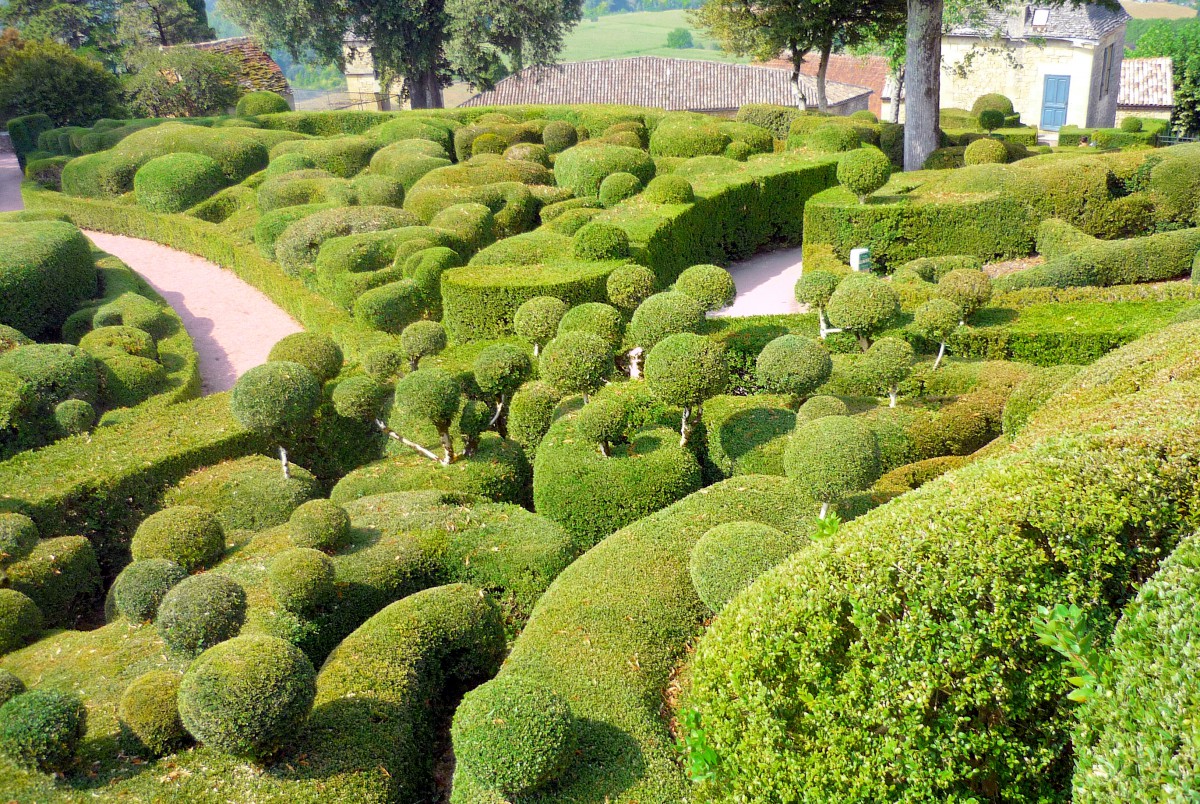
Unique of its kind, the suspended gardens of Marqueyssac are one of the finest achievements in the history of French gardens.
Laid out on a rocky spur overlooking the Dordogne Valley between La Roque-Gageac and Beynac, the Marqueyssac Gardens cover an area of 22ha.
The terrace gardens’ charm has delighted visitors for the last three centuries, and there is no doubt that Marqueyssac has become one of France’s most beautiful Italian-style gardens.
The spectacular bastion terrace is made up of numerous box trees carefully pruned by the estate’s four gardening employees. Cypress trees also give structure to the landscape.
The box trees are all sculpted in curves to mimic the roundness of the surrounding hills, and it can be rather enjoyable to get lost along the winding paths of this green labyrinth.
Find out more about the Gardens of Marqueyssac.
The exquisite gardens of Eyrignac
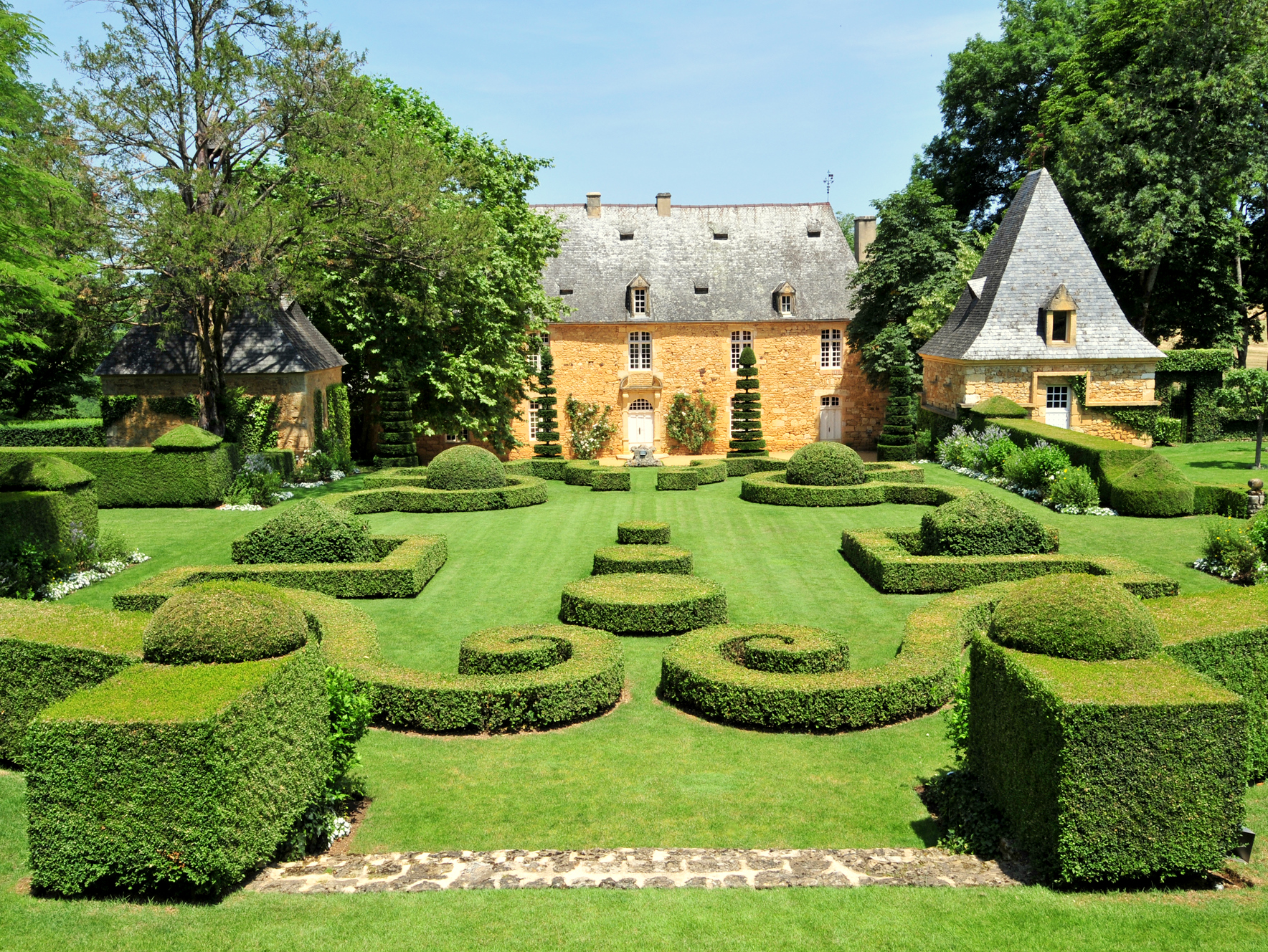
The gardens of the Manor of Eyrignac (Jardins du Manoir d’Eyrignac) are located in the commune of Salignac-Eyvigues in Périgord Noir, 13 km north-east of Sarlat-la-Canéda.
Open to the public, the magnificent gardens are a typical example of French formal gardens with perfectly manicured hedges and wonderful perspectives.
This garden style is based on symmetry and the principle of imposing order over nature. French landscape architect André Le Nôtre designed formal French gardens for King Louis XIV in the 17th century.
The highly influential gardens of Versailles, Vaux-le-Vicomte and the Tuileries definitely inspired the planting plan in Eyrignac.
Find out more about the Gardens of Eyrignac.
The botanical garden of Limeuil

The botanical garden of Limeuil (Jardin ethnobotanique de Limeuil) was founded in 1980 as a collaboration between botanists, ethnologists, and historians to display plants of ethnobotanical importance.
Opened to the public in 1992, the museum offers visitors the opportunity to discover different sections of planting representing Prehistoric France, the neolithic era, pre-Roman Gaul, Gallo-Roman culture, the Middle Ages, the Renaissance, and contemporary cultivation.
The garden terrace commands a fine view over the confluence of the Dordogne and Vézère Rivers.
Find out more about Limeuil and the botanical garden.
Beautiful Sites of the Dordogne Valley

Cingle de Montfort
![Cingle de Monfort © Manfred Heyde - licence [CC BY-SA 3.0] from Wikimedia Commons](https://frenchmoments.eu/wp-content/uploads/2012/11/Cingle-de-Monfort-LR-©-Manfred-Heyde-licence-CC-BY-SA-3.0-from-Wikimedia-Commons.jpg)
West of Souillac and South of Sarlat is the Cingle de Montfort, located at a picturesque bend in the Dordogne River. A ‘cingle’ is a local geographical word referring to the idea of ‘meandering’.
To enjoy a fine view of Montfort Castle, drive along the D703 between Montfort and Carsac and park the car in the parking area.
There, the fine panorama over the cliff encompasses the Cingle de Montfort and the Turnac Peninsula, covered with groves of nut trees. To the right stands the Montfort castle on top of its promontory.
The Belvédère de la Barre in Domme

In Domme, visitors can enjoy one of the nicest views over the Dordogne Valley from the “Belvédère de la Barre”, near the 17th-century church rebuilt after the Wars of Religion.
This spectacular panorama includes views of the Dordogne Valley and stretches from the Montfort Meander to the village of La Roque-Gageac.
You can also turn left and follow the “Promenade des Falaises” (Cliff Walk) to the “Jardins Publics du Jubilé,” where an orientation table will help you understand the significance of Domme’s famous neighbouring sites.
Find out more about Domme.
The Belvedere of the Marqueyssac Gardens
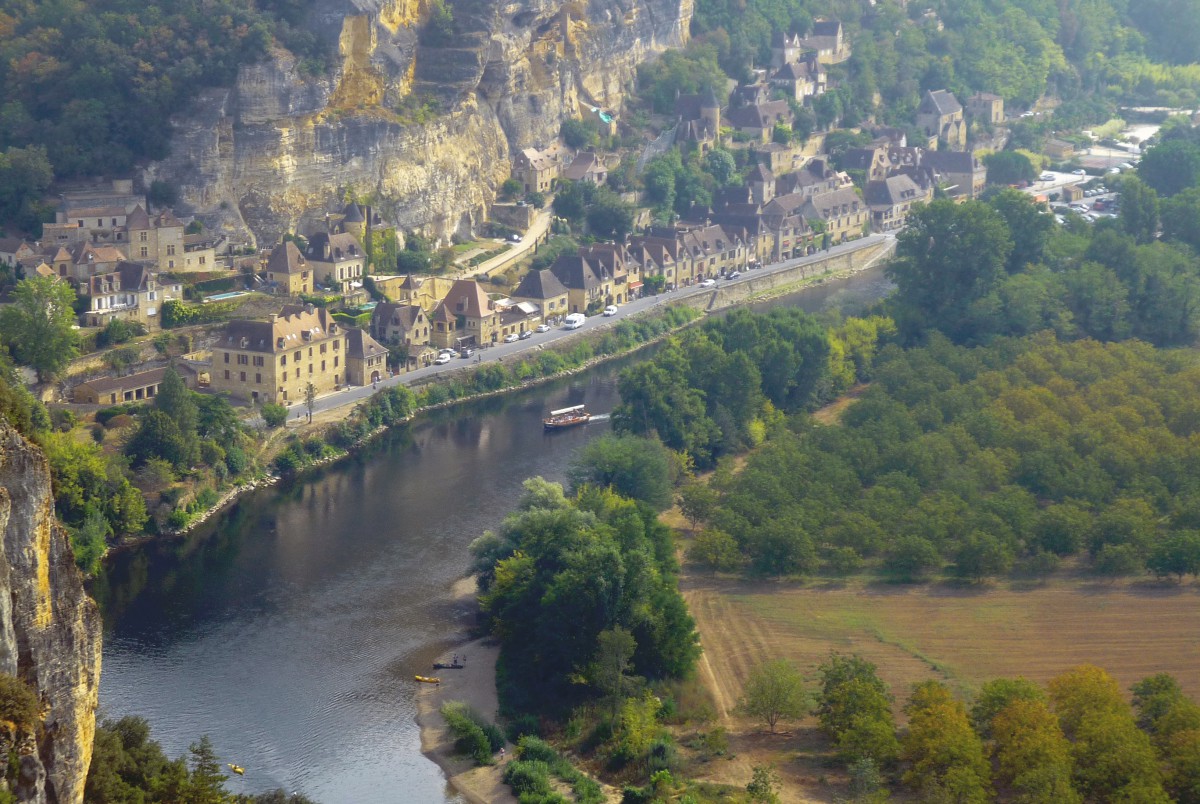
While the gardens of Marqueyssac overlook the Dordogne Valley from high limestone cliffs, it is at the belvedere one can enjoy one of the most splendid panoramas of the meandering river running 130 metres below.
From the lookout point, originally laid out by Julien de Cerval, the view encompasses the whole valley, from the castles of Beynac, Castelnaud and Fayrac to the village of La Roque-Gageac.
Find out more about the Gardens of Marqueyssac.
The view from the keep of Beynac Castle
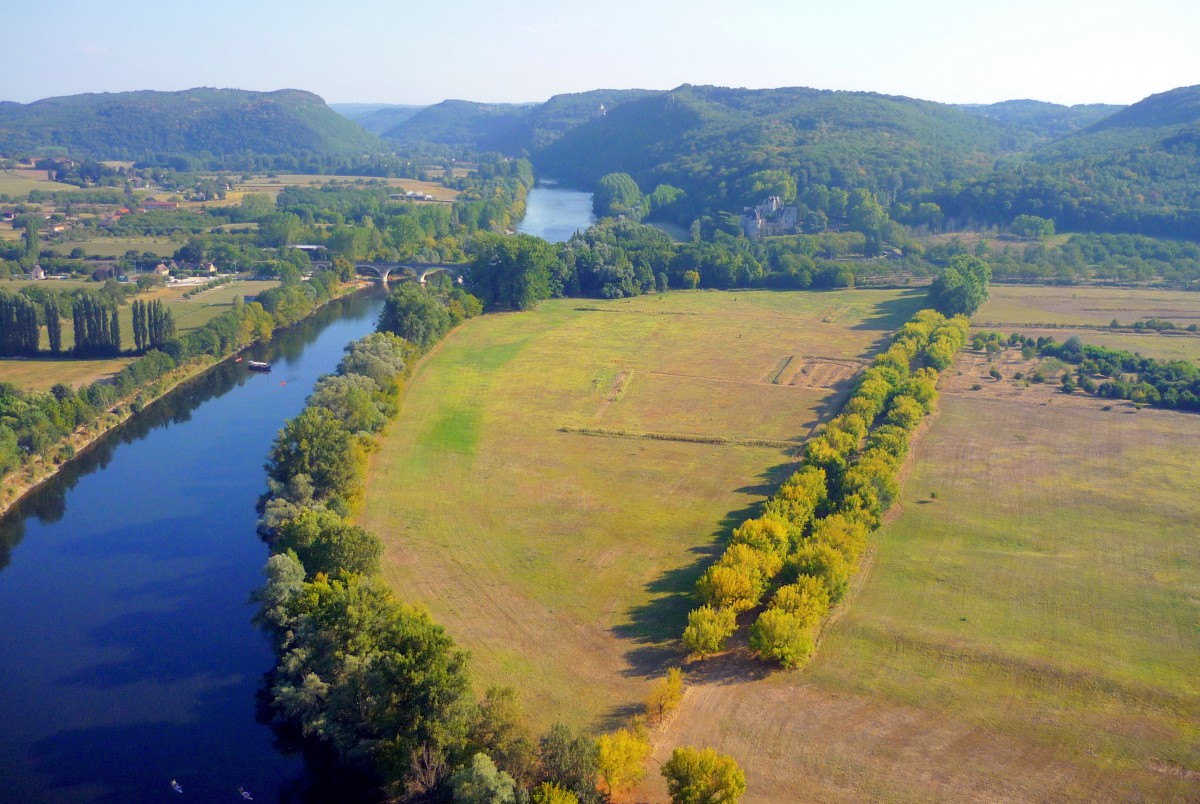
The last staircase to the top of Beynac Castle climbs to the watchpoint, which looks towards the south bastion.
The panoramic view encompasses the Dordogne Valley and the castles of Marqueyssac, Castelnaud, and Fayrac.
Find out more about Beynac.
The terrace of Limeuil’s Botanical Garden
Although the views from the top of Limeuil’s Botanical Garden are not as spectacular as those from Marqueyssac or Beynac, the panoramic vista at the top still offers an interesting view of the Dordogne Valley and the confluence of the Dordogne and Vézère Rivers.
Find out more about Limeuil.
The Cingle of Trémolat
![Cingle de Trémolat © Père Igor - licence [CC BY-SA 3.0] from Wikimedia Commons](https://frenchmoments.eu/wp-content/uploads/2012/11/Cingle-de-Trémolat-LR-©-Père-Igor-licence-CC-BY-SA-3.0-from-Wikimedia-Commons-.jpg)
Just outside the village of Trémolat, the Dordogne River follows a big meander with wooded limestone steep hills to the outside and flat rural land inside the loop.
Called “Cingle de Trémolat“, this large river curve is a popular tourist attraction.
The view from the belvédère stretches about 180 degrees over the Dordogne Valley.
English-French Vocabulary
(f) for féminin, (m) for masculin and (v) for verbs
- abbey = abbaye (f)
- Albigensian Crusade = croisade des Albigeois (f)
- battle = bataille (f)
- barge (on the Dordogne) = gabare/gabarre (f)
- belfry = beffroi (m)
- bell tower = clocher (m)
- castle = château (m)
- church = église (f)
- cliff = falaise (f)
- cloister = cloître (m)
- cobbled street = rue pavée (f)
- to discover = découvrir (v)
- Dordogne Valley = Vallée de la Dordogne
- Eleanor of Aquitaine = Aliénor d’Aquitaine
- English = Anglais (m), Anglaise (f)
- fortress = forteresse (f)
- French = Français (m), Française (f)
- garden = jardin (m)
- Gothic art = art gothique (m)
- hill = colline (f)
- house = maison (f)
- Hundred Years War = Guerre de Cent Ans (f)
- keep = donjon (m)
- knight = chevalier (m)
- landscape = paysage (m)
- lane = allée (f)
- to list = classer (v)
- market hall = halle (f)
- meander = méandre (f)
- Middle-Ages = Moyen-Âge (m)
- moat = douves (f)
- narrow street = ruelle (f)
- nut tree = noyer (m)
- to overlook = surplomber (v)
- pilgrim = pélerin (m)/pélerine (f)
- pilgrimage = pélerinage (m)
- priory = prieuré (m)
- promontory = promontoire (m)
- Renaissance = Renaissance (f)
- Richard the Lion Heart = Richard Cœur de Lion
- river = rivière (f)
- river trading = commerce fluvial (m)
- rocky spur = éperon rocheux (m)
- Romanesque art = art roman (m)
- Santiago de Compostela = Saint-Jacques-de-Compostelle
- street = rue (f)
- terrace = terrasse (f)
- tower = tour (f)
- view = vue (f)
- village = village (m)
- to visit = visiter (v)
- Wars of Religion = Guerres de Religion (f)
Find out more!
Your visit to Périgord Noir can continue with the not-to-be-missed town of Sarlat-la-Canéda to the Northeast, the Valley of the Dordogne towards Bergerac, and eastwards in the Haut-Quercy.
Discover the tourist sites on the blog:
The official website of the Tourist Board of the Périgord Noir – Vallée Dordogne.

